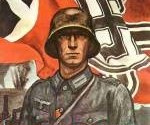|
Perhaps the single most recognizable symbol of the German army in WWII is the German Stalhelm, or helmet. It was a universally
issued item that saw action in every front of the war, and it had more variety in construction technique (the m35, 40, and
42 models), Paint colour (from Apple Green to Feldgrau and everywhere in between.) and Decal application. Add on to this
the fact that it was not an exceptionally uncommon occurrence for the individual soldaten to camouflage it, either with paint
or banding of some sort, and you have a very interesting animal indeed.
Nowadays, when I go onto the reenactment field, I see a number of different methods that reenactors use to represent the
German helmet in WWII. Most commonly, I see one of three things. 1. Single (and sometimes double) decaled helmets of all
models. 2. Single or non decaled full camouflage schemes, and 3. Single or non decal with a foliage strap of some sort. Rarest
of all field helmets out there on the reenactment field is a plain Jane non decaled non camoed helmet.
The question is, however, how authentic these practices are, and what ratio should we be seeing the variants in out units.
The first issue to address is the model of helmet that you own. Most reenactors use an original helmet (although there
are some repros out there that arent too bad, I havent seen them on the field en masse yet. As most novice reenactors can
tell you, there were three main models of helmets, the M35, M40, and M42 helmet. Each model was a simplification on the previous
model, and they had marked differences.
The main differences between the three models is as follows:

M35: The M35 was the first model manufactured, and it had many extra features that sets it apart from the later models of
helmet. Mainly the fact that it had two piece air vents and a rolled rim.

M40: The M40 is the second model of helmet which took into effect some of the time and cost saving changes from the earlier
model helmet. Primarily the change from a two piece vent to a stamped vent hole. It did, however, retain the rolled rim.

M42: The final helmet model. The M42, much like the later tunics, was a bare bones model of its predecessor. This model
dropped the rolled edge completely, giving it a much sharper silhouette
From the above information and pictures, it should be fairly easy to distinguish the type of helmet that you own.
The second article in this series can be found in the reenactor articles section, and covers how to refurbish your helmet
for reenacting.
Or, you can follow the link below.
The German Helmet Part 2
|

